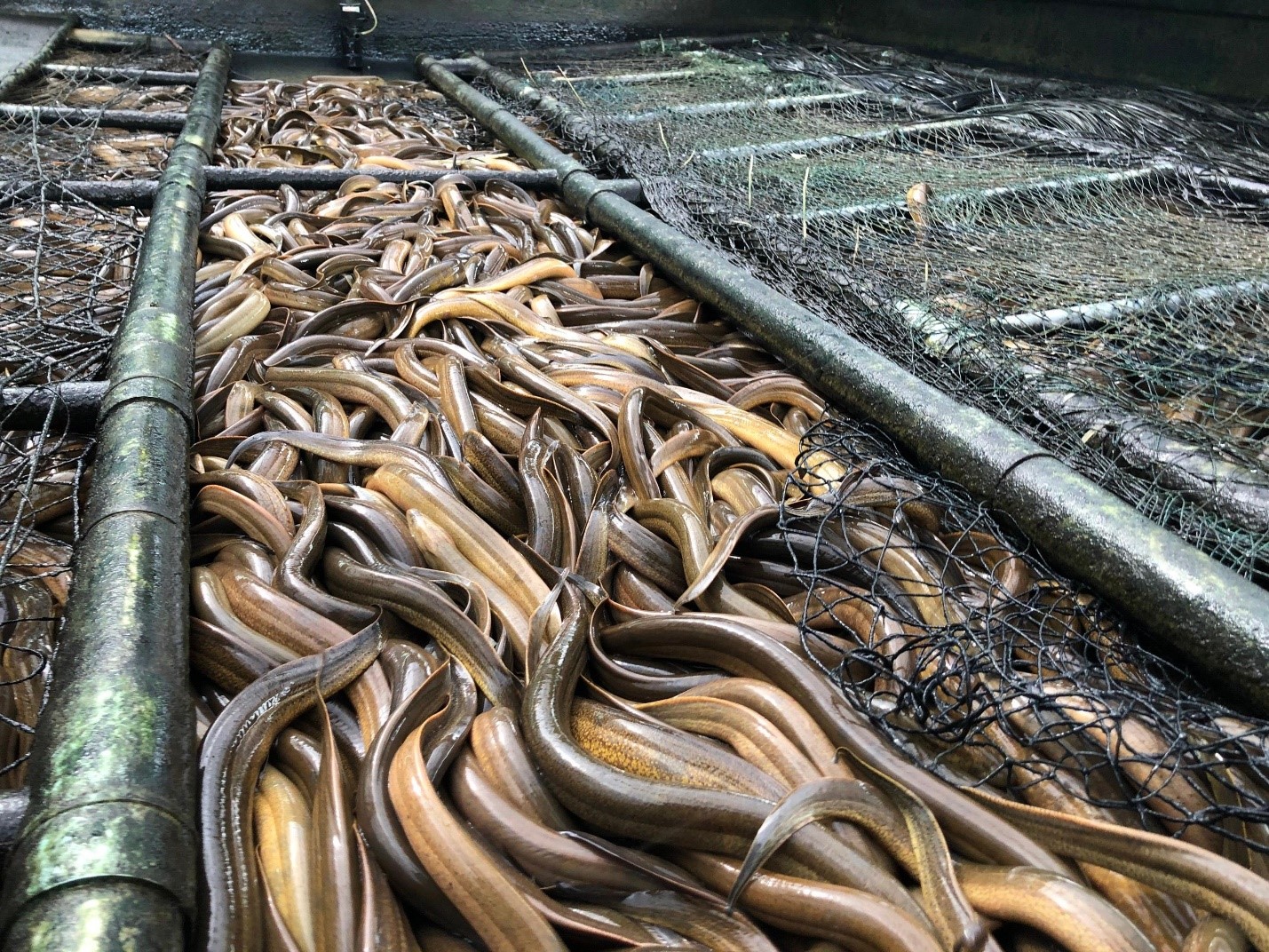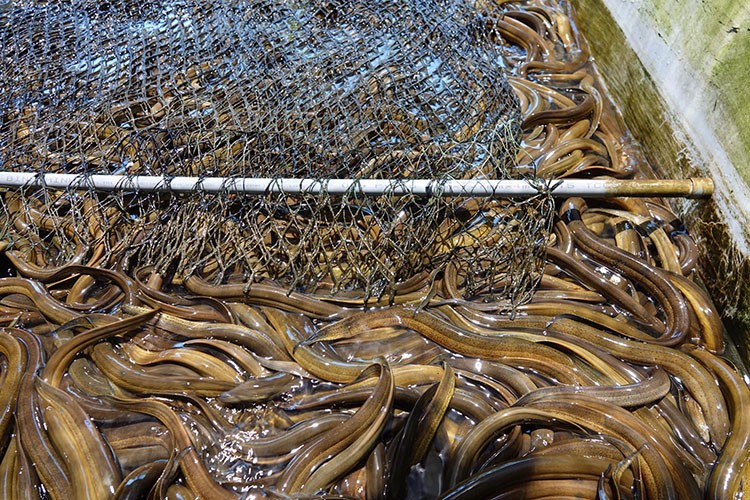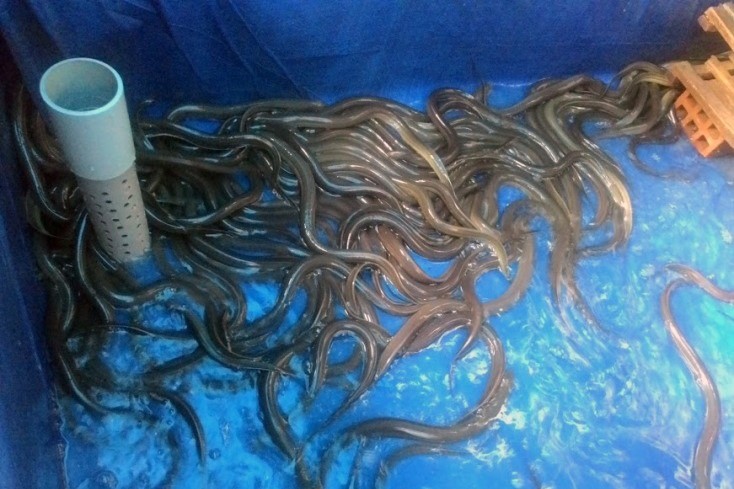Eel farming brings high economic value because of their nutritional value, especially mud-free commercial eel farming is the most popular with the advantages of stable quality, less space and time consuming.
Eel is a type of seafood that is very popular in the market because it has high nutritional value, rich in protein, vitamins and minerals. The most effective and popular form of eel farming today is raising it in mud-free tanks. Mud-free commercial eel farming is currently an effective model for farmers. Because this model is less time consuming, easy to apply techniques but gives high income. What are the techniques of raising commercial eels without mud, bringing economic efficiency?

Image of Mud-free commercial eel farming
1. ABOUT THE AQUARIUM
Eels can be raised in cement tanks, composite tanks or tarpaulin lined tanks. Or farmers can take advantage of old unused pig barns to raise eels. Suitable area is 5 – 10 square meters, build a wall around the tank with a length of about 0.8 – 1 m. The tank wall is 0.8 – 1 meter high; has a thickness of 10 – 15 cm; Water depth is 0.2 – 0.4 meters. Tank construction materials can be made of bricks and stones. The entire inside surface of the tank needs to be tiled or smooth with cement. The tank needs to have drainage to facilitate care and water changes. The bottom surface tilts toward drainage about 2.5 – 3 cm. Manholes must be covered with nets to prevent eels from escaping. The top of the tank is covered with a roof. And the water surface of the tank can be planted with duckweed to protect against the sun, favorable for the growth of eels. The appropriate water temperature for raising eels is 25 – 27 degrees Celsius, PH reaches 7.0 – 8.5. In addition, commercial eel tanks should have a water tank to filter and change water when necessary. You can make a shelter for eels using nylon ropes bundled into bunches or bamboo tubes, bricks, or wood.
2. FARMERS NEED TO PAY ATTENTION
– For old tanks: After harvesting, drain the water, wash the tank and dry it for 25 – 30 days, mix with lime powder and brush the inside of the tank. The purpose is to destroy pathogens in the aquarium.
– For newly built tanks: After adding water to the tank, soak the banana tree trunk for 10-15 days, then drain and rinse with clean water. Do this 2-3 times before adding water to the tank
Image of Mud-free commercial eel farming
3. REGARDING BREEDING SELECTION
Eel release season is usually from March to April of the solar calendar. There are currently two sources of eel breeds for farmers to choose from: wild ones and artificially or semi-artificially bred ones.
Farmers should choose breeds that have uniform weight, healthy, have bright colors, dark yellow backs, swim quickly, and skin that is not scratched or lost viscosity. With a seed size of about 40 – 50 fish/kg, stocking density should be 80 – 160 fish/square meter. Before releasing, the eels should be bathed in salt water with a concentration of 2 – 3% for about 5 – 10 minutes to disinfect the eels and remove parasites, and also disinfect wounds caused by scratches during the catching process or transportation. The appropriate time to release them is when the weather is cool and release them gently into the tank.
Note: The source of breeding stock is mainly exploited from natural breeds, so it is necessary to have a pure tank and size classification before putting it into commercial farming. During the first 1-2 days, do not feed the eels to help them adapt to the captive environment. Net density 3 – 5 kg/square meter, water change 1 – 2 times/day, netting time 5 – 7 days.
4. ABOUT CARE
There are two types of feed for eels: industrial feed and natural feed. Whether or not eels grow and develop well depends largely on these two types of feed.
Their food is mainly trash fish, worms, snails, mussels, etc. Because they need high protein for at least 30% of their diet. Therefore, you can feed eels about 6-7 portions of clams, snails, mussels or trash fish, plus 3-4 portions of bran from rice, corn, and tapioca. Food should be steamed. Periodically add digestive enzymes, Vitamin C at a dose of 4 – 5 g/kg of feed or mix garlic into the feed at a dose of 4 – 5g/kg of feed to increase resistance and prevent disease for eels.
The characteristic of eels is to eat at night. Therefore, feed them about 80% of the feed at night, and feed the remaining 20% during the day. Change their water once every morning. During the first week, feed exclusively in the evening. Then, slowly practice feeding the eels earlier. When they eats strongly, you can feed them twice a day with an amount of 5-7% of their body weight. After about 3 – 4 hours of feeding, check the feeding net again to see their ability to catch prey, to adjust the amount of feed accordingly next time. When the eels are adults, feed them once a day in the cool afternoon. After feeding them for about 2 hours, check the amount of bait on the floor to remove leftover food and trash from the tank.
Image of Mud-free commercial eel farming
5. ABOUT MANAGEMENT
Periodically check environmental factors such as: PH, Oxygen, NH3, etc. before and after each tank water change. From January to February, change 100% of the water every 1-2 days in the aquarium. Every month, you should check and classify the eel’s size to facilitate care and avoid eating each other. During the raising process, you must regularly observe if any animal is injured and must be separated for treatment. When detecting unusual signs of eels such as eating less, some swimming apart from the group or raising their heads, it is necessary to find the cause to take timely measures.
Use potassium permanganate (KmnO4) at an amount of 2 – 3 g/cubic meter of water every 2 weeks to spread evenly throughout the tank to prevent disease in them or use some biological products suitable for them.
After 3-4 months of farming, when they reach commercial size, harvesting is carried out. Before being sold, they should be fasted for 1 day. After harvesting, the tank needs to be cleaned to prepare for raising the next batch.
Mud-free commercial eel farming brings high economic benefits, and the above effective farming techniques help farmers achieve high efficiency.


